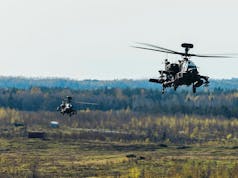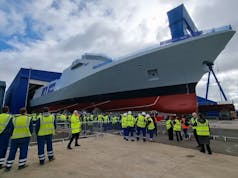Leonardo, with the support of the UK’s 847 Naval Air Squadron, presented its AW159 Wildcat helicopter to Malaysia’s Armed Forces at Royal Malaysian Navy Base Lumut and Leonardo Helicopters’ facility at Subang Airport, near Kuala Lumpur last week.
The two AW159 Wildcats are currently deployed as part of the French Navy’s five month amphibious deployment, Exercise Jeanne d’Arc, to the Middle East, Asia and South Pacific and are embarked on the helicopter assault ship FS Dixmude to provide a battlefield reconnaissance capability to the deployed forces.
According to the manufacturer Leonardo, the AW159 has a semi-rigid rotor head which gives it high agility and the same legendary ship operating capabilities of the Lynx helicopter. It is also fitted with composite rotor blades utilising the same technology that enabled the Lynx to break the world helicopter speed record. The AW159 is powered by a pair of LHTEC CTS800-4N engines, each providing up to 1,361 shp, which gives the aircraft exceptional performance, even in hot and high environments.
“The AW159 has the most modern integrated cockpit of any naval helicopter, featuring four large area (10″ x 8”) cockpit displays and a fully integrated avionics suite and mission system to provide increased mission capability and increased crew effectiveness. The key sensors integrated into the AW159 include the Leonardo Seaspray 7000E series Active Electronically-Scanned Array (AESA) radar, a dipping sonar system, electro-optical device and Leonardo electronic warfare systems. A range of weapons can be carried, including torpedoes and air-to-surface missiles, on its weapon carriers.
The UK’s Royal Navy and British Army operate 62 AW159 Wildcats in both naval and over land roles including ASuW, ASW, maritime surveillance and battlefield reconnaissance, while the Republic of Korea Navy operate eight AW159 helicopters in ASW and ASuW roles.
The Philippine Navy has also ordered two AW159s that will be delivered next year. The Royal Malaysian Navy currently operates the Leonardo Super Lynx 300 helicopter in the Anti-submarine warfare (ASW) and anti-surface warfare (ASuW) roles.”
The British Army’s variant of the Wildcat is almost identical to the Royal Navy variant with the only major equipment differences being the Army aircraft do not have the Seaspray 7000E series AESA radar or weapon carriers.













I wasn’t sure how the Wild Cat would fair in the export market now that it is fully Italian owned, I thought Leonardo would be pushing their Italian models in the export market. It did well to win contracts in S Korea and the Philippines, the market is so competitive these days and the Wild Cat tends to be more expensive compared to its competition.
What competition? The Wildcat is alone in its niche.
Mainly the Sea Hawk (old but cheap) I think Leonardo market the AW139/149 in maritime role, there is also the NF90 the Dophine and an increasing number of cheaper UAV’s that will be able to perform the ASW role in the future.
They’re much bigger. If you want a small ship’s helo, the Wildcat is pretty much alone.
Does the UK MOD have a technology stake in the wildcat?
I think you mean: does the MoD have IP ownership? The answer is yes.
Perhaps it’d make more of an impact if it had some missiles to show off.
So you didn’t actually look at the headline picture.
What are they anyway? I thought Skua had been retired and Venom and Martlet not in service yet.
Mock ups perhaps or is that a legacy photo?
that pic is a cgi rendering… the crew are a dead giveaway 😉
Lol i see what you mean.
[…] post Leonardo and 847 Naval Air Squadron pitch the AW159 Wildcat helicopter to Malaysia appeared first on UK Defence […]
Malaysia was the launch customer for the Super Lynx 300 so a logical place to market the Wildcat to.
Does the UK version have the dipping sonar?
No, not deemed necessary as Merlin does. Personally I think that is a bit short sighted but lack of a dipping sonar pails into insignificance vs the more pressing issue of no tactical data link being fitted to the type.
Ahh…. shortsightedness…. the hallmark of uk procurement….. almost always down to budget reasons…… not that were alone in this! couple examples…f22 raptor, zumwalt destroyers, etc, etc.
Is there any plan to address the lack of the data link? I think I read it was planned but the funding subsequently never allocated or funding that had been allocated was cut at some point.
Five years late, lots of beer and much thinking. When you asked the question about dipping sonar for Wildcat I would argue that it was not needed. Now with the start of the T83 program I would say yes Wildcat should have a dipping sonar.
Each T83 should have two Wildcats to work inner guard for the carrier group. With two T83s per carrier that gives four Wildcats. As they are working inner guard then we could possibly have some VL-ASROC on the frigates and destroyers say four per ship. The rocket has 20km range and then the torp a further 10km. So if each ship has four VL-ASROCs that should be enough for what I call inner guard, 50km out from the carrier. Further out is the job of the future T26s and Merlins. Some would say but why when the enemy can launch a missile out from 100km. Simple to launch a missile an enemy sub must come close to the surface, the missile must pop up to have a look then air defence will see and have a good chance of shooting the missile down. For a brave sub commander, you get in close, then two torps and get out. Gutsy, but sub skippers are brave if not the most cold blooded, intelligent, clever, sly, underhanded up close and personnel knife fighting guys that any nation has in their armed forces. I say this not out of malice but respect.
A bit of track but I really do hope that the future T83s could have a hanger space for two Wildcats and two Apaches. Back to the Wildcat, there is possibly a diffrent solution, if the Schiebel S-100 can be fitted with a sonar buoy pod much like the Sea Guardian/ Mojave. If yes then they could work together with the Wildcat. As for the future T83 lets turn it into a helicopter cruiser. Four helicopters such as Wildcat/Apache with a twin flight deck, 4 S-100s, 96 Mk 41s, 16 canister SSMs such as the NSM, a 5 inch gun with Vulcano shells, 3x 40mm guns, 2x CIWS, 2x 30mm guns and 4x GAU-19s.
Be good to get some orders for the 159. If only we could get HMG to commit to the AW149 as the new meduim lift to replace puma UK rotor would be nice and safe for decades.
My assumption is that the puma will quietly get retired with no replacement.
Let’s hope they do at least invest in the existing frames and add the data link capability, which seems fundamental to them being able to do their role fully.
We certainly want to maximise the number of these around the south china sea.
So many spelling errors.
Just let it go, not using keyboard.
The lack of export orders for the maritime version is very disappointing.
The market in general wants more capable and therefore heavier platforms like S70 and NH90.
The army version of wildcat, like the army version of Lynx, is a complete waste of army should have procured Blackhawks for the British Army.
(Chris H) Mike Saul – Why would we want to export UK jobs to the USA to procure an aircraft that is older and inferior in power, speed, lift, numbers of people lifted by AH149 let alone a Merlin?And with nowhere near the technology on offer in a Wildcat.
Low risk, low costs, proven platform.
Or older, slower and heading towards the end of its life. Invest in the future and our own rotor capability is what we should be doing. we already have production lines for a superb meduim lift that’s actually closer to heavy lift (Merlin) and the most advanced light military rotor out their, all we need is a modern true meduim rotor production line and we will be golden for a couple of decades. Leonardo have already promised the AW 149 production line to the UK if the MOD buy it and it’s a really very good meduim rotor, faster, longer range, better lift and most importantly far more survivable in a crash than a Blackhawk (infact there is a fairly good chance the US will go for a US build version of the AW139/149 for its next meduim lift).